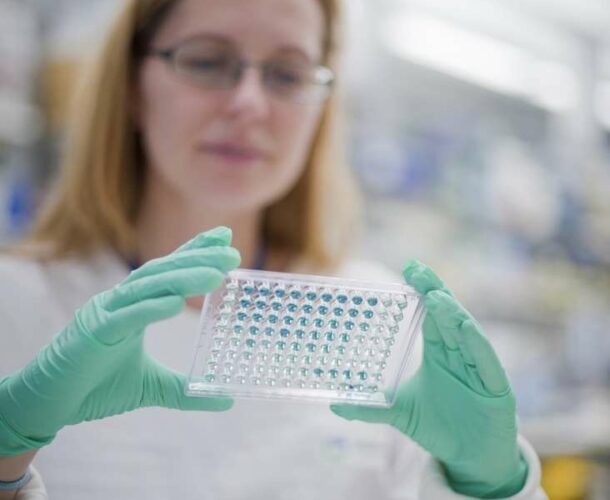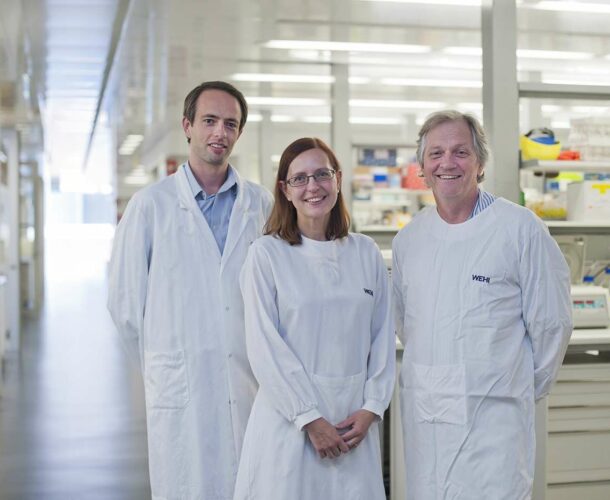Professor David Tarlinton, Dr Ingela Vikstrom and Dr Victor Peperzak overturn a long-held belief about how the immune system keeps its memory cells alive.
Making memories
Memory B cells are essential for long-lived immunity to infection after immunisation.
To develop into memory cells, B cells have to survive the natural process of apoptosis, or programmed cell death, that occurs following a large immune response.
‘Memory’ B cells are made in germinal centres – temporary ‘boot camps’ where the immune system teaches itself to recognise and kill foreign pathogens.
The most effective memory B cells are selected for further specialisation and become antibody-secreting cells. These are sent to live in the bone marrow, where they make antibodies that provide a person with long-term protection from viruses and bacteria.
“Memory B cells, which include plasma cells, are produced after vaccination or infection and are responsible for the protective immune ‘memory’ that can persist in humans for 70 or 80 years,” Tarlinton says.
Keeping memory alive
In a study published in the journal Science, the team identifies that the ‘survival’ protein Mcl-1 is essential for memory B cell survival. The discovery rewrites a long-held belief about how the body’s immune system maintains its memory.
Tarlinton, who has spent almost 20 years studying the molecular machinery of B cells, said the discovery was unexpected.
“It surprised us to find that, contrary to popular belief, Mcl-1 is the essential pro-survival protein required for creation and maintenance of all B cell memory.”
The story becomes even more complicated in 2013 when they discover that memory B cells also rapidly destroy the very protein that keeps them alive.
“Plasma cells critically rely on Mcl-1 for survival, yet they are constantly degrading and destroying the protein in the cell, effectively signing their own death warrant,” Tarlinton says. “However the body continually grants a ‘stay’ of execution by instructing the cell to make new Mcl-1.
“Effectively, Mcl-1 is its own failsafe mechanism, an internal timer. And – if it runs out –the cell self-destructs.
He says the discoveries prove how much we still have to learn about the cells that keep us alive.
“B cells and antibody production are the key to the success of all currently used vaccines in humans. It is critical that we understand the molecular interactions that lead to immune function, which are still only vaguely understood.”
Dangerous consequences
Tarlinton says that, as with any immune cell, plasma cells are vital, yet can also be dangerous.
“When plasma cells are ‘out of control’, they continue to make antibodies that can be very damaging if there are too many.”
This happens in conditions such as myeloma – a cancer of plasma cells – and various forms of autoimmunity, such as systemic lupus erythamatosus or rheumatoid arthritis.
Tarlinton hopes the discovery will help to develop new treatments for these conditions.
“Myeloma is a cancer that has a particularly poor prognosis, and is generally considered incurable,” Tarlinton says. “And some forms of lupus are a sentence to lifelong suffering due to the effects of autoantibodies.”
“Now that we know Mcl-1 is the one essential protein keeping plasma cells alive, we have begun ‘working backwards’ to identify all the critical molecules and signals needed to switch on the protein.
“We hope that we will identify some point in the internal cell signalling pathway, or a critical external molecule, that we can block to stop Mcl-1 production in plasma cells. This would be an important new platform for therapeutic targets in diseases that currently have no specific or effective treatment, such as myeloma, or offer new treatment options for people who don’t respond well to existing treatments for diseases, such as lupus or rheumatoid arthritis.”




